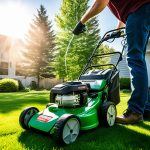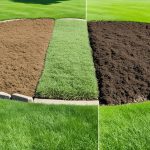A well-maintained lawn can dramatically boost your home’s curb appeal, making a positive first impression on visitors and potential buyers. Enhancing your lawn doesn’t require months of work or a substantial budget—there are several quick methods to improve its appearance and overall impact on your property’s exterior.
Your front lawn serves as the welcome mat for your home, setting expectations for what lies beyond the front door. Even small improvements can yield significant results, transforming a dull or neglected yard into an attractive feature that complements your home’s architecture and style. The following tips offer practical ways to quickly elevate your lawn’s appearance without extensive landscaping knowledge or professional help.
1) Mow your lawn frequently to maintain a neat appearance
Regular mowing is one of the quickest ways to improve your lawn’s appearance. A well-trimmed lawn gives your entire property a clean, cared-for look that neighbours and visitors notice immediately.
For most grass types, cutting once a week during the growing season keeps your lawn looking its best. This frequency prevents grass from becoming too long and untidy between cuts.
The height of your cut matters as well. Set your mower blade to remove only the top third of the grass blades. Cutting too short can stress the grass and create opportunities for weeds to take hold.
Change your mowing pattern each time you cut the grass. This helps prevent the grass from leaning in one direction and creates a more uniform appearance with attractive mowing lines.
Sharp mower blades make a significant difference in your lawn’s appearance. Dull blades tear rather than cut grass cleanly, leaving ragged edges that can turn brown and look unhealthy.
Properly timed mowing in the morning or evening, when temperatures are cooler, helps reduce stress on the grass and contributes to a healthier, better-looking lawn.
2) Edge along driveways and paths for crisp boundaries
A well-defined edge between your lawn and driveways or paths instantly elevates your property’s appearance. Clean edges create visual appeal by establishing clear boundaries that separate different areas of your landscaping.
Creating these sharp edges is simple with the right tools. A manual edging tool or powered edger will help you cut a clean line between grass and hard surfaces. For best results, aim for a depth of about two inches.
Regular maintenance keeps these borders looking their best. Plan to edge your lawn every two to four weeks during the growing season to prevent grass from creeping onto pavements.
The contrast between a neatly trimmed lawn and a paved surface draws the eye and frames your garden beautifully. This small detail makes a significant difference to your home’s kerb appeal.
After edging, sweep or blow away grass clippings from paths and driveways for a truly polished look. This finishing touch completes the neat appearance you’re working to achieve.
3) Apply a high-quality lawn feed in early spring
Timing is essential when feeding your lawn. Early spring is the perfect moment to apply a high-quality lawn feed, as this gives your grass the nutrients it needs right as it begins its growth cycle.
Choose a feed with the right balance of nitrogen, phosphorus and potassium. Nitrogen promotes lush green growth, phosphorus supports root development, and potassium helps your lawn resist disease and drought.
Always read the product instructions before application. Most feeds need to be applied when the soil is moist but the grass is dry, and many require watering in afterwards.
For best results, use a proper spreader rather than applying by hand. This ensures even coverage and prevents the patchy appearance that can come from uneven application.
Remember that different lawn types may need different formulations. Cool-season grasses benefit from slightly different nutrient balances than warm-season varieties.
Mark your calendar for this task each year. A well-fed lawn in early spring sets the stage for a healthy, attractive garden throughout the growing season.
4) Overseed bare patches with a shade-tolerant grass mix
Patchy lawns with bare spots can diminish your home’s kerb appeal quickly. These unsightly areas often develop in shaded regions where standard grass struggles to grow properly.
Shade-tolerant grass mixes are specially formulated to thrive in areas that receive less sunlight. Look for varieties such as fine fescues, rough bluegrass or certain ryegrass types that specifically mention shade tolerance on the packaging.
Spring and early autumn are the best times to overseed your lawn. Begin by loosening the soil in bare patches with a garden rake. This improves seed-to-soil contact for better germination rates.
Apply the seed mixture according to the package instructions, typically at a rate of about 30-40 grams per square metre. Cover the seeds with a thin layer of topsoil to protect them from birds and help retain moisture.
Water the newly seeded areas lightly twice daily until germination occurs. Reduce watering frequency once seedlings reach about 2.5 cm tall, but ensure the soil remains consistently moist until fully established.
5) Aerate compacted soil to improve root growth
Compacted soil restricts grass root growth and limits water absorption. When soil becomes too dense, roots struggle to expand, leading to weaker grass that’s more vulnerable to drought and disease.
Aerating your lawn solves this problem by creating small holes in the soil. These openings allow air, water and nutrients to penetrate deeper into the ground, encouraging stronger root development.
You can aerate your lawn using a manual core aerator for small areas or a mechanical one for larger lawns. The best time to aerate is during the growing season when grass can recover quickly, typically spring or early autumn.
For heavy clay soils or areas with high foot traffic, annual aeration is recommended. Sandy soils may need it less frequently, perhaps every two to three years.
After aerating, it’s a good opportunity to overseed and apply fertiliser. The holes provide direct contact between seeds and soil, improving germination rates.
Within a few weeks, you’ll notice improved drainage and healthier grass growth. Your lawn will become more resilient against drought and better able to utilise nutrients.
6) Water deeply but infrequently to encourage strong roots
Proper watering techniques can make a significant difference in your lawn’s appearance and health. When you water deeply but infrequently, grass roots grow deeper into the soil to seek moisture. This creates a stronger, more drought-resistant lawn.
Most lawns need about 2.5 cm of water per week, either from rainfall or irrigation. It’s better to provide this water in one or two thorough sessions rather than daily light sprinklings.
Morning is the best time to water, preferably between 4 am and 10 am. This timing reduces evaporation and allows the grass to dry before evening, helping prevent fungal diseases.
You can check if your lawn needs water by walking across it. If your footprints remain visible or the grass doesn’t spring back, it’s time to water.
A simple rain gauge can help track how much water your lawn receives. Alternatively, place empty tuna tins around your lawn while watering to measure depth.
Remember that different soil types require different watering schedules. Clay soils hold water longer, while sandy soils drain quickly and may need more frequent watering.
How a Well-Maintained Lawn Elevates Curb Appeal
A beautiful lawn serves as the foundation of your home’s exterior appearance. It creates a positive first impression for visitors and potential buyers while enhancing the overall aesthetic of your property.
The Visual Impact of Lush Grass
A healthy, green lawn instantly transforms a property’s appearance. The vibrant colour creates a striking contrast against the home’s exterior and complements landscaping features.
Regular mowing establishes clean, defined edges that give the property a tidy, well-cared-for look. The uniform height (typically 2.5-4 cm) creates a carpet-like appearance that’s visually appealing.
Weed control is essential for maintaining this polished look. A lawn free of dandelions, clover and crabgrass appears intentional and well-maintained rather than neglected.
The texture of healthy grass adds another dimension to your kerb appeal. Dense, thick turf has a lush quality that looks and feels premium compared to patchy, thin grass.
Influence on Property Value
Estate agents consistently rank lawn appearance among the top factors affecting buyer interest. Studies show homes with attractive lawns sell up to 15% faster than comparable properties with neglected outdoor spaces.
A well-maintained lawn signals to potential buyers that the property has been properly cared for. This perception often extends to assumptions about the home’s interior condition as well.
Professional valuations frequently include exterior appearance in their assessment criteria. A £500-1,000 investment in lawn improvement can yield returns of 3-5 times that amount in property value.
The cost-benefit ratio of lawn maintenance is exceptionally favourable. Basic upkeep like regular watering, mowing and fertilising requires minimal investment but delivers significant visual improvement.
For UK homeowners, a neat lawn remains a cultural expectation. Properties that meet this standard often attract more viewings and higher offers in competitive markets.
Common Challenges in Achieving a Healthy Lawn
Creating and maintaining a beautiful lawn often involves overcoming several obstacles that can prevent grass from thriving. Soil issues and pest problems are two major hurdles many homeowners face when trying to improve their lawns.
Addressing Soil Compaction
Soil compaction occurs when soil particles are pressed together, reducing the space for air, water and root growth. This common problem happens in high-traffic areas or after heavy machinery use.
To test for compaction, push a screwdriver into your lawn—if it’s difficult to insert, your soil likely needs help.
The solution? Aeration. This process creates small holes in the soil to allow air, water and nutrients to reach grass roots. You can hire a professional or rent an aerator from a garden centre.
Best times for aeration:
- Spring (March-April)
- Autumn (September-October)
After aerating, apply a thin layer of compost (0.5-1 cm) to introduce beneficial organisms. This helps break down thatch and improves soil structure.
For severe compaction, consider adding sand to clay soils to improve drainage. Limit foot traffic on wet lawns to prevent future compaction issues.
Managing Lawn Pests and Diseases
Pests and diseases can quickly turn a lush lawn into a patchy mess. Early identification is key to effective treatment.
Common UK lawn pests:
- Leatherjackets (crane fly larvae)
- Chafer grubs
- Ants
- Worms (beneficial but can create casts)
Look for brown patches, chewed grass blades or small tunnels as signs of infestation. Birds pecking at your lawn often indicate a grub problem beneath the surface.
Biological controls like nematodes offer an environmentally friendly option for pest management. Apply them when soil temperatures are 12°C or higher.
Fungal diseases such as red thread and fusarium patch thrive in damp, poorly drained conditions. Improve air circulation by reducing shade and ensuring proper mowing height (3-4 cm for most grasses).
Regular lawn care practices—proper watering, fertilising and mowing—strengthen grass’s natural defences against both pests and diseases.





